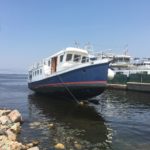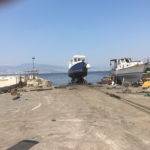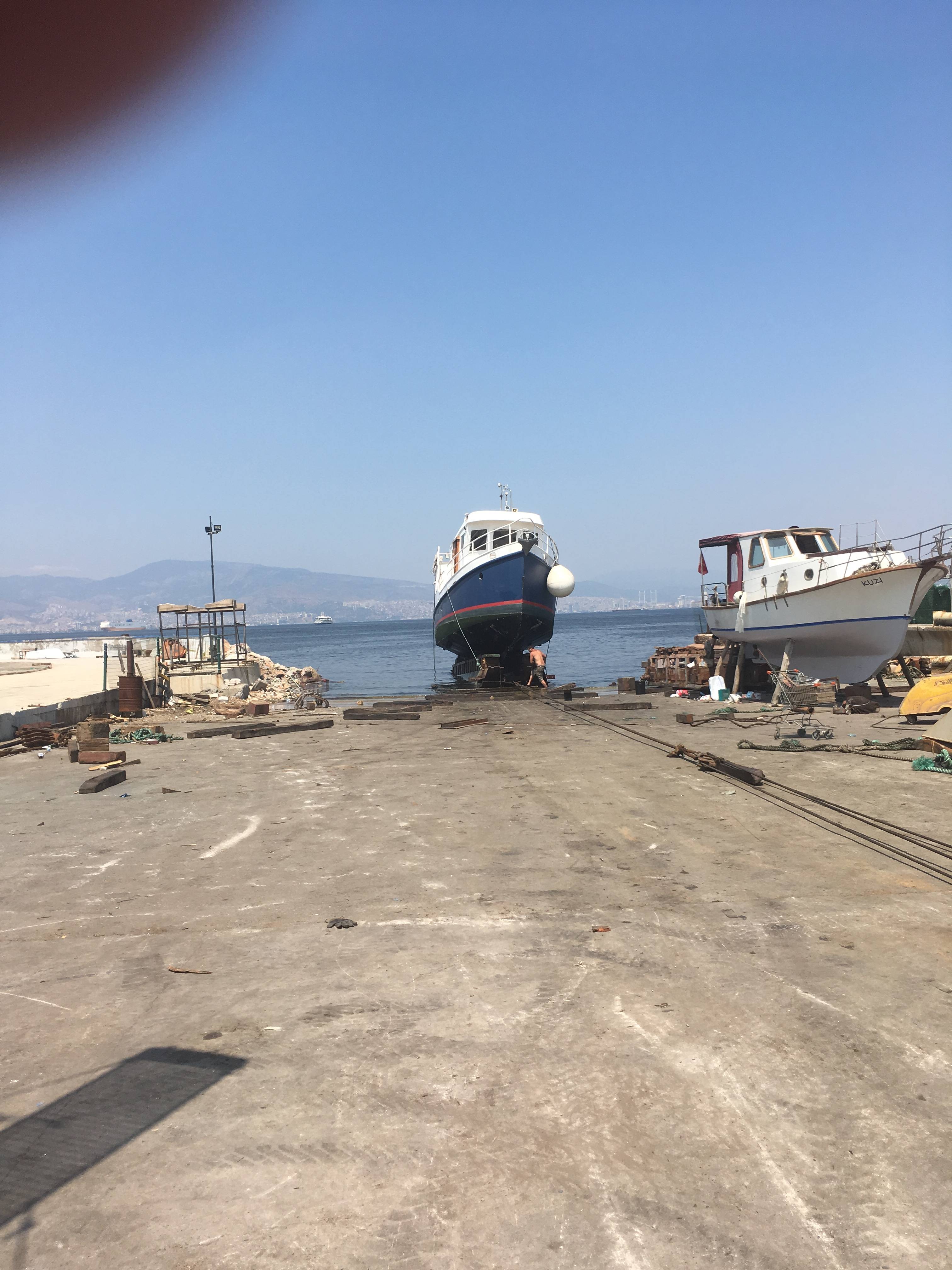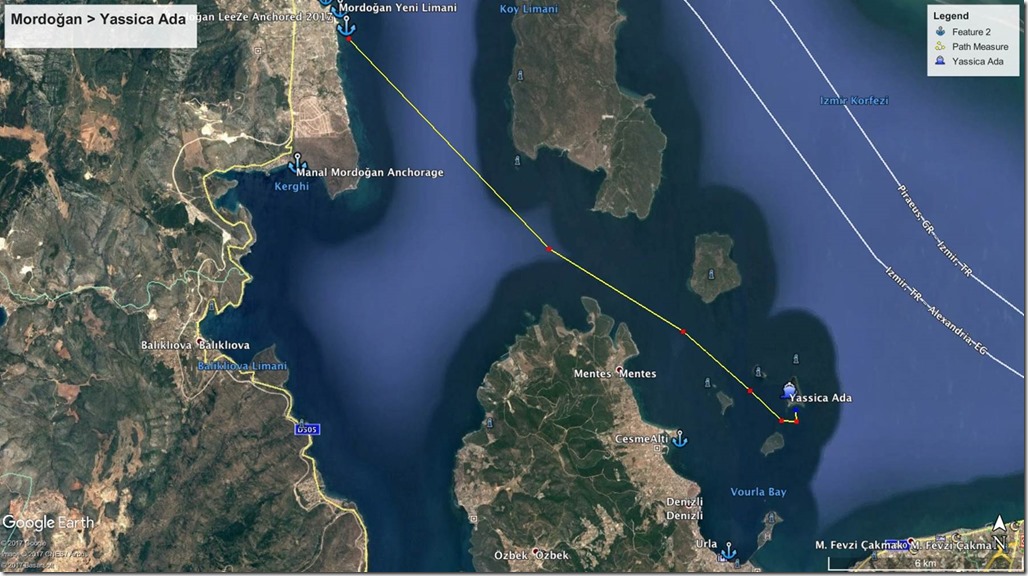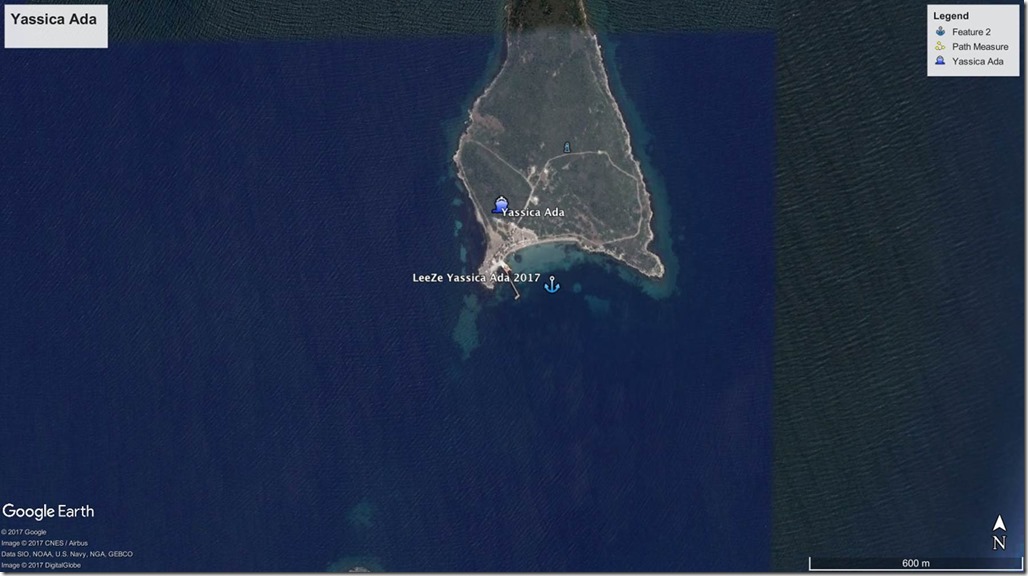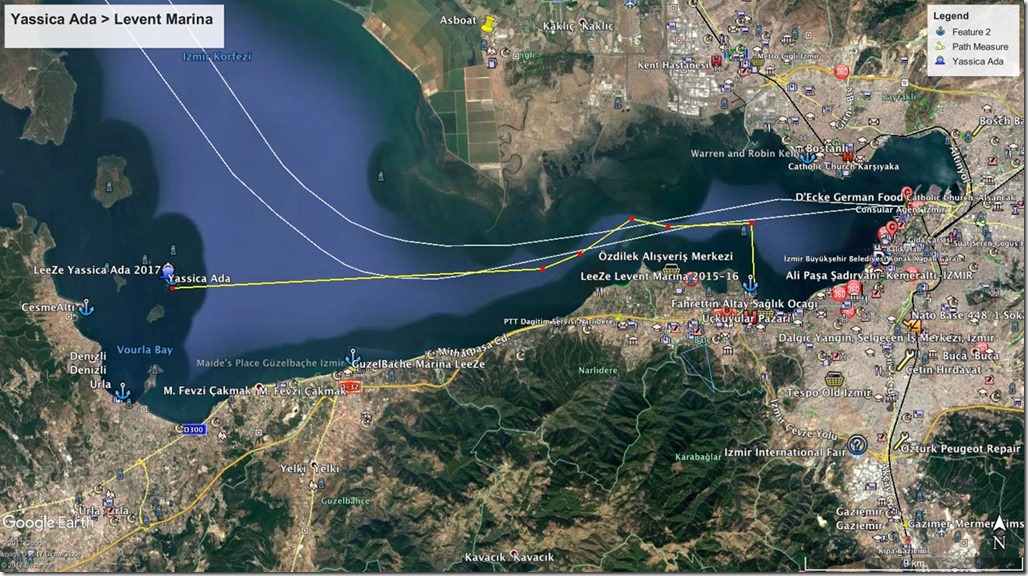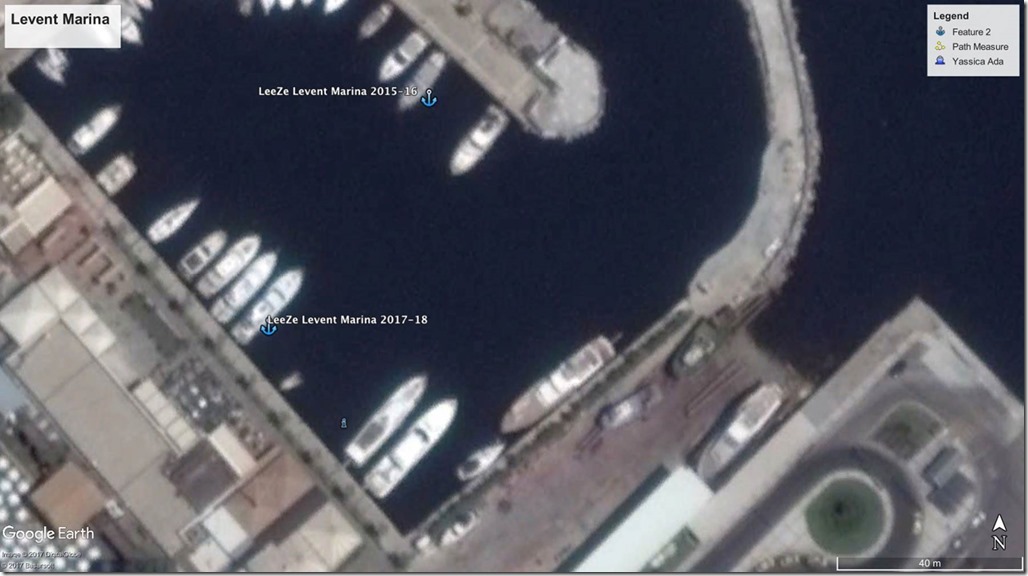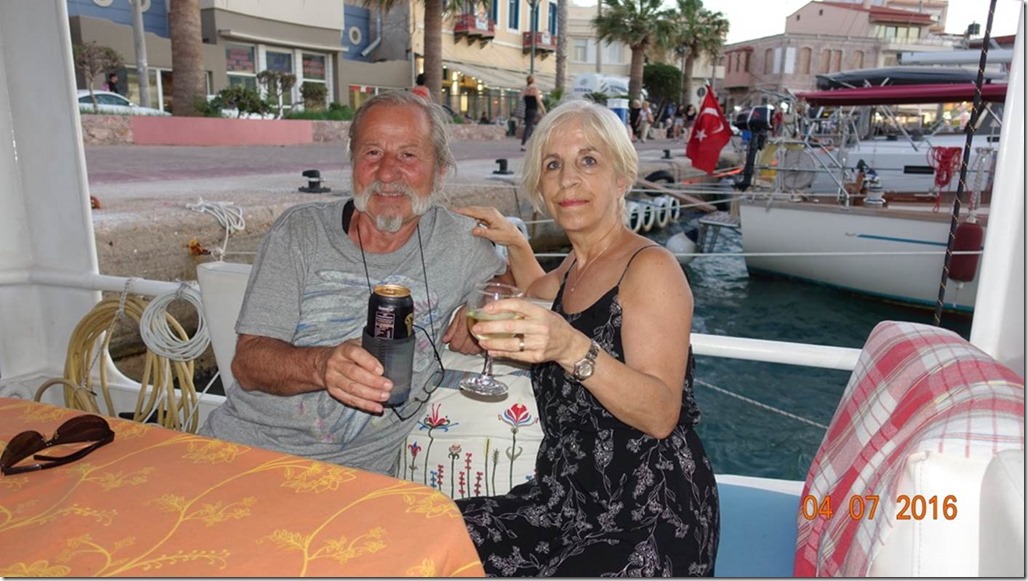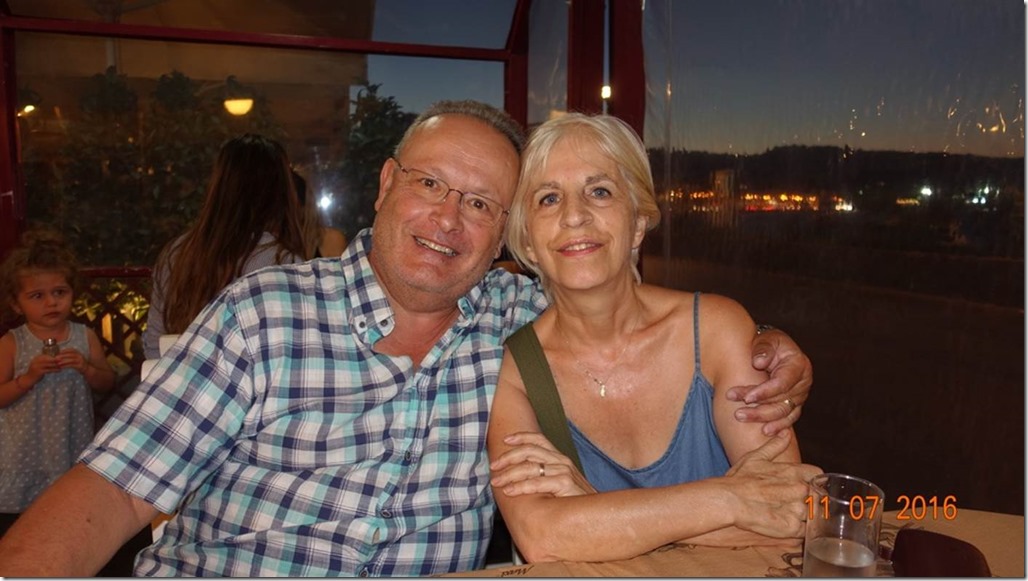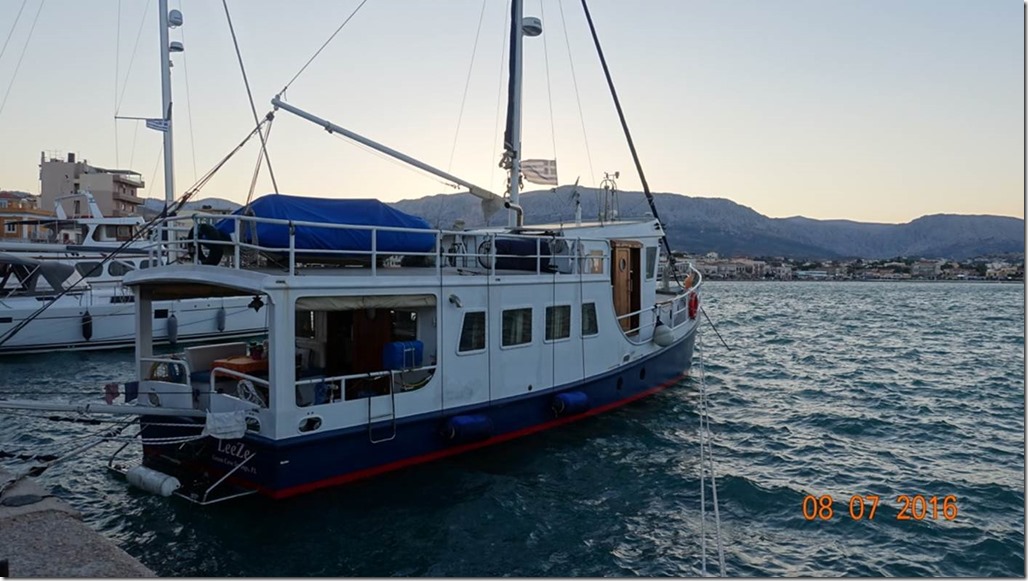We have decided to sell our beloved Diesel Duck Trawler LeeZe. The blog posts on this site are some of our adventures during our time cruising and meant to shed some light on the cruising life. Enjoy our posts and please contact us for more information on the places we have been or information on our Diesel Duck Trawler LeeZe in Çandarli. The complete collection of our travel blogs can be found here: http://whereisleeze.blogspot.com
2015-09-13: Yesterday, after anchoring,

knowing that the wind was going to pick up, elected to lower the tender from the boat deck into the water. That turned out to be a wise decision as later yesterday and so far today, the wind has not slowed to below 20 knots.
Therefore, spent most of last night on the couch in the saloon, waking up every two hours to check. Seemed like we had dragged as the mosque and castle and shore are MUCH closer than when I went to sleep a few hours earlier, but having panicked before and got my heart racing to check only to find that I within my swing circle, I decide to believe that I had not dragged and that all was fine.
When we set the anchor yesterday, as soon as I drop it I mark the spot electronically on my chart plotter. I had 60+ meters of chain out (in about 8 meters of water) and had Zehra back down at slightly above idle until you can see the chain get quite taut. I then attach my 22 mm 12 strand snubber, lay out another 10+ meters and have Zehra back down again, slowly, until the snubber is taut, then have her increase RPMs until the water is starting to be squeezed out of the line and the line noticeably thins.
So, this AM, when I thought I might be dragging, I remembered all that and also remembered that whenever we anchored using that process, the anchor has never dragged.
So, this morning, Zehra thinks we have dragged. Fire up the navigation suite and measure the distance ween the spot I marked and our current position. We are within 65 meters of the anchor so I am quite confident that we did not drag, or dragged sooooooo little that it is imperceptible.
After breakfast, prepare the tender and our plans are at about 1700 to venture into town. The wind is blowing 25-30 knots with gusts up to 40 from the NE. When we get a gust, LeeZe is heeled by the wind until she is aligned with the wind. We have come to learn by the healing alone how big of a gust that was. We are usually right within 5 knots for gusts up to 60. Not much experience above 60, and care not to have any.
Our intentions are to mosey our way south, anchor MAYBE in Aliağa, Yeni Foça, Eski Foça, and then turn into Izmir Bay, making our way toward Bostanli, where LeeZe was launched, and stay there a week or so. We would like to be in our marina (Levent) on or around 1 Oct.
That’s our plans. Let’s see how well we hold to that plan.
2015-09-16: We left Çandarli yesterday and anchored in the afternoon in Eski Foça.
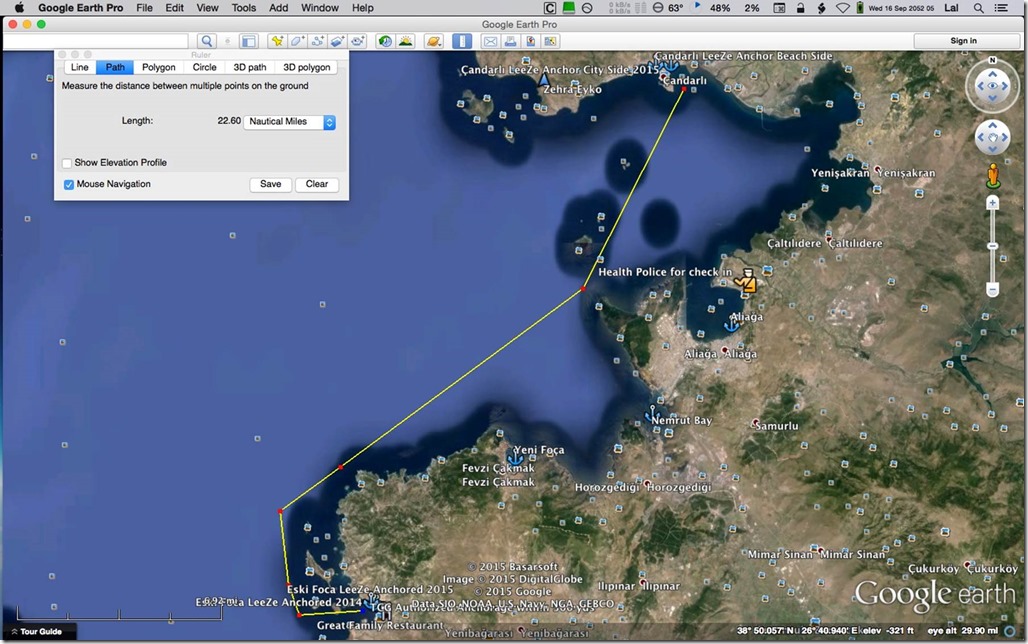
Zehra had taken a dolmuş (a type of minibus / van where multiple people are all heading generally in the same direction) to Aliağa and learned that they COULD possibly make some room for us but they were not sure, and there would be no access to water of shore power.
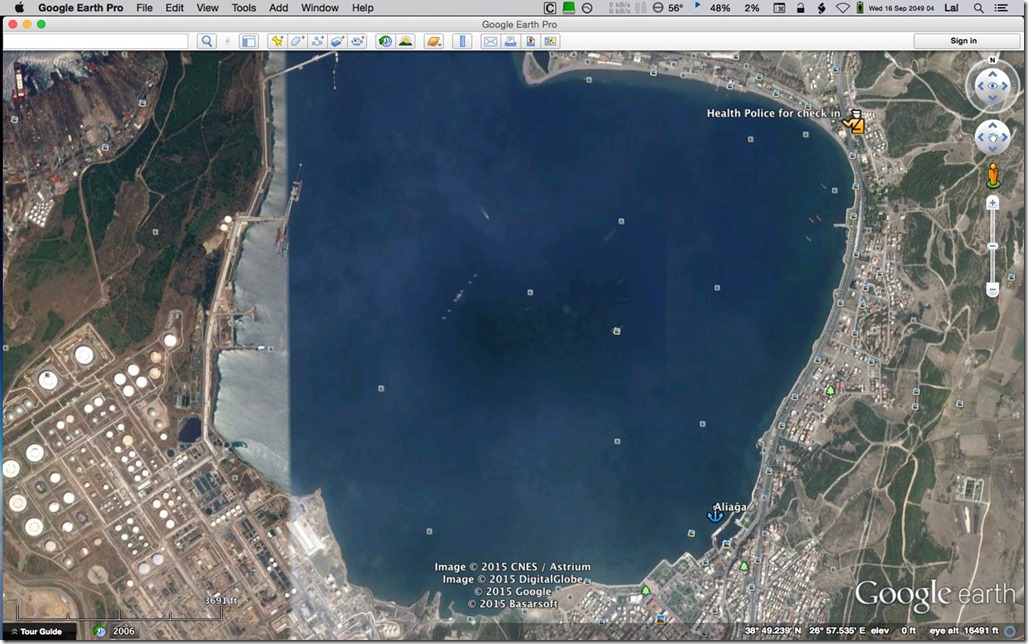
So we passed.
“Intel” told us that we would be wasting our time anchoring in Yeni Foça
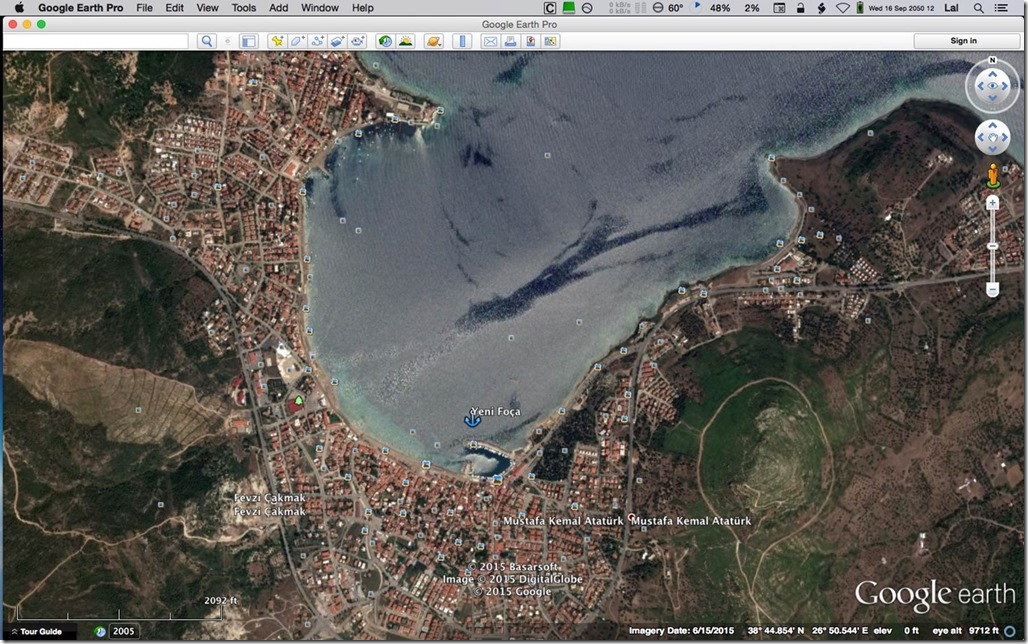
so we moved on to here. The ride was good for the most part, with the wind mostly behind us and the waves mostly off our starboard quarter.
When we arrived, using the position the Turkish Coast Guard gave to us last year as a spot within 300 meters to anchor, we did. The wind was 20 knots out of the NE and the bay was rolly.
I laid out 60 meters of chain and then snubbed another 10. Depth of water was between 9-11 meters. But something went wrong.
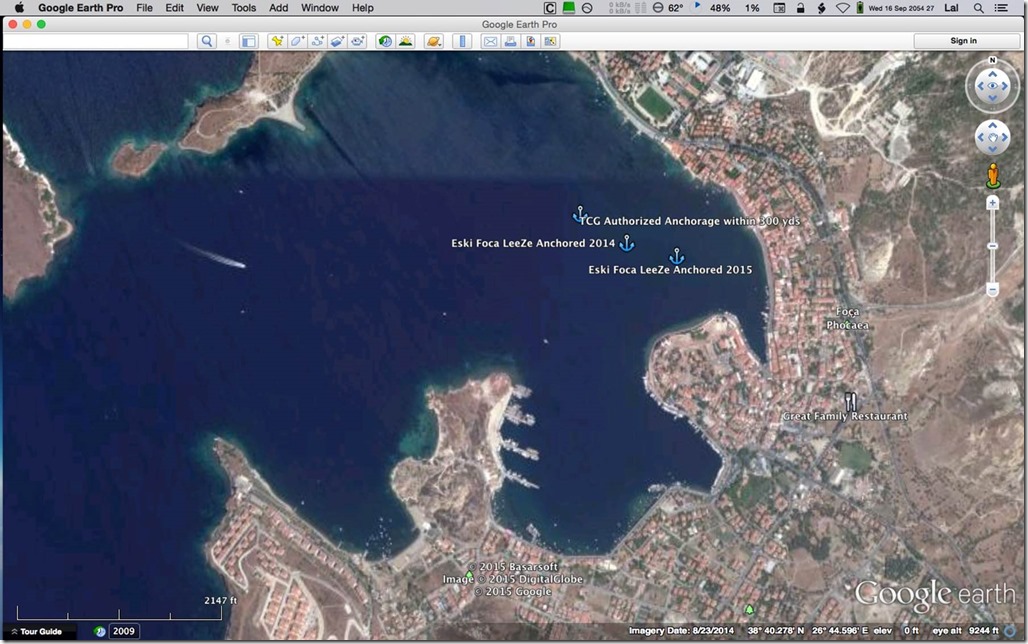
Normally, I put a second snubber on the chain just BEFORE the anchor windlass as a backup in case the first snubber comes off the chain. Sometime after 2200, LeeZe started feeling not like herself, and I felt it, I think, even though the wind was 25+ knots, gusting to 40.
Yup, the first snubber had come off.
Working fast but safe in the dark with a small head light, was able to retrieve the snubber’s end and re-attach it to the chain. But, without having started the engine, I knew it would be foolish to bring in any chain so at the 80 meter mark, I attached the snubber again and let it out until it had the strain and the second snubber did not. At this time, I saw I had just about 100 meters of chain out.
I know the saying: “The anchor chain does no one any good sitting in the locker” (this is quoted to me by some many captains of day trip gulets that I now roll my eyes when I hear it) but I only have 130 m on board and I do not like the fact that at 2300 at night, I am left with few options to make me feel more comfortable.
We made it thru the night and this morning, the sea was calm and flat, with no wind. I woke up to see I was blocking a major portion of the channel and the castle / fort’s walls to the south of me looked remarkably close!
So, after coffee and before breakfast, start the engine and start retrieving all that chain that I had put out last night. Depth of water is 10 meters, and at the 60 meter mark, reattached the primary snubber. This time I take my time and make sure it is attached securely. I also lay out 10 meters of snubber line because, maybe, just maybe, I had laid out too much snubber (can one do that?) and somehow, laying on the bottom, the snubber got loose. Do not know.
After making sure that the snubber had the load, Zehra backed LeeZe down and confirmed that the Roca was holding.
This evening, Zehra wants to try anchoring in other part of the bay, closer to the North end. She thinks there will be less roll motion. We will try that tomorrow.
2015-09-20 Well, we ended up not moving as whatever was causing the sea to roll seem to stop. But this September weather has not been as kind and bright to our solar panels as June was and so the house battery was going down faster than I liked.
I thought something maybe draining it and looked around. Our digital satellite receiver had some unusual lights lit on its front, given that we were not using it. When I felt the case, it was quite warm to the touch. Pulled the plug and battery voltage jumped up 0.40 vdc. So, that was my drain. But after 3 days, that box took a lot out of the battery and so I was worried.
Thought we were getting underway YESTERDAY ((thought yesterday was Sunday!) so started up the engine in preps to move. House Bank was at 23.75 VDC but the engine lit off like a champ. (Never have learned the lower limit for engine start! Guess I need to!) But the Admiral squared me away and after an hour, shut down the engine. The alternator added about 80 amp hours during that hour, not enough to make an appreciable dent in the 1250 amp-hr bank.
So, started up the genset and ran it for ~2 hours until regardless of the manual load I set for the chargers, the genset was only putting 60+ amps into the bank. (The genset did get very hot. See the note at the end of this blog for the full story.)
We went out for dinner and, well to make a long story short, this morning the bank was at 24.57 VDC, and I was quite comfortable with that state of charge. (For those that want to know, full with no charge is about 1 volt more, and with the chargers on, a trickle charge is 2 volts more. Equalization charge is just over 30 volts and the battery chargers take care of deciding when and for how long.)
Underway this morning to check to see if there is room for us in Güzelbaçhe’s marina under construction. If not, the “bingo field” field CeşmeAlti. Our underway was complicated by some fish and net gear that got around the anchor and chain. It was sooooooo heavy that is was difficult to lift completely out of the water. So, got into the tender and with Zehra raising the anchor slowly, cut it all away. But it was dirty; it got me dirty; it got the tender dirty. It was a dirty job. ☺
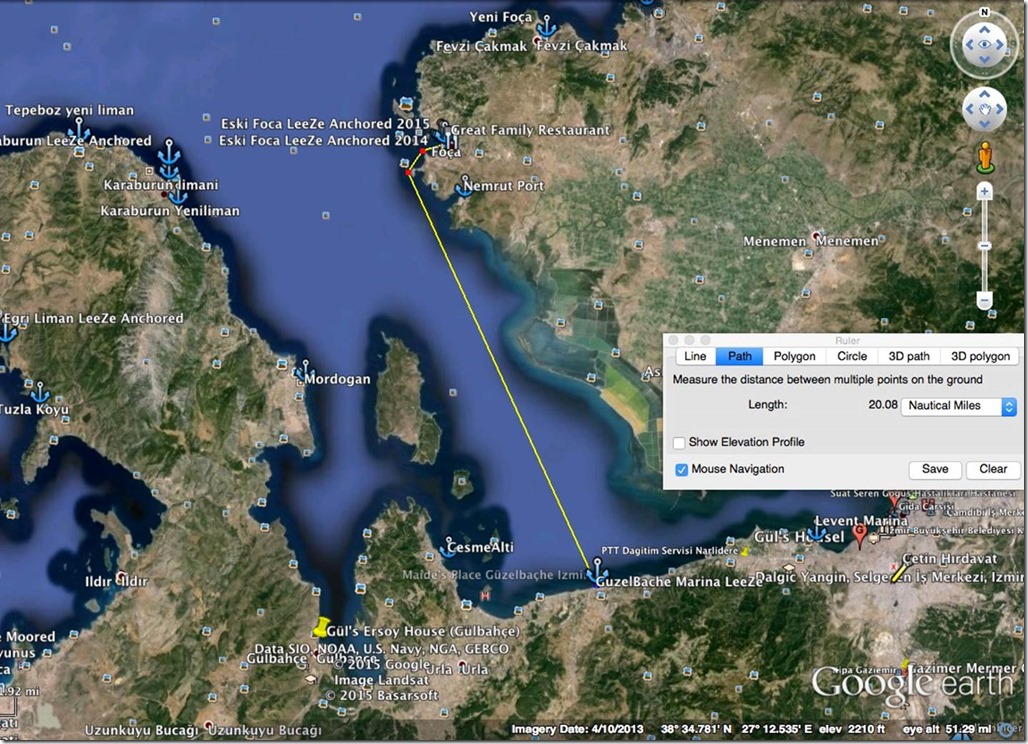
While underway and south of Eski Foça, received six VHF DSC (distress) announcements from both Olympia (Greek) and Turk Radio. Each reported thee different capsized craft, all off the coast of BabaKale / Lemnos Island and each asking ship in the area to kindly keep a watch for them, reporting accordingly. The first report was for 26 souls, the next for 10, and the last for 44. An afternoon press report by Hurriyet newspaper reported that none of the 26 were found as of the filing of the report.
Today seemed like a superb day for the refugees to travel. There was little wind, no rough seas, and the sun was out. But nearly all the boats are overloaded, with questionable engines, and few have life vests. Some reports indicate that the really cheap life vests are full of water absorbing foam. It appears that the smugglers are making money two ways!) Some say nearly 8% of those who brave the sea to get to an EU country die at sea. May their souls rest in peace.
Just under two week ago, we passed Babakale and did see one migrant craft in the water, on the Greek side, who waived us off because my guess is he wanted to be rescued by the Greeks.
I was nowhere near the area but asked myself if I was prepared to pick up 20-30 “souls” and if I did, even if I reported it by radio, could I get into some trouble legally, that is. Were we prepared in any way to host these people. I know we have enough tea and coffee, but are definitely lacking in changes of clothes and blankets. If I did run into situation, I would obviously pick up all of them, hope it is a sunny day, have them rest in the sun on the forward deck and boat deck, give them water, tea or coffee, and IMMEDIATELY contact the appropriate coast guard people for instructions. But I am in uncharted waters here and if any of the readers of this blog can provide advice, I would welcome it. (please note that the Greek and Turk radio announcements ask ships in the area to keep a sharp lookout and report what they see. The announcement does NOT ask the ships to effect rescue!)
Any way, while the landing at Güzelbaçhe was not perfect,
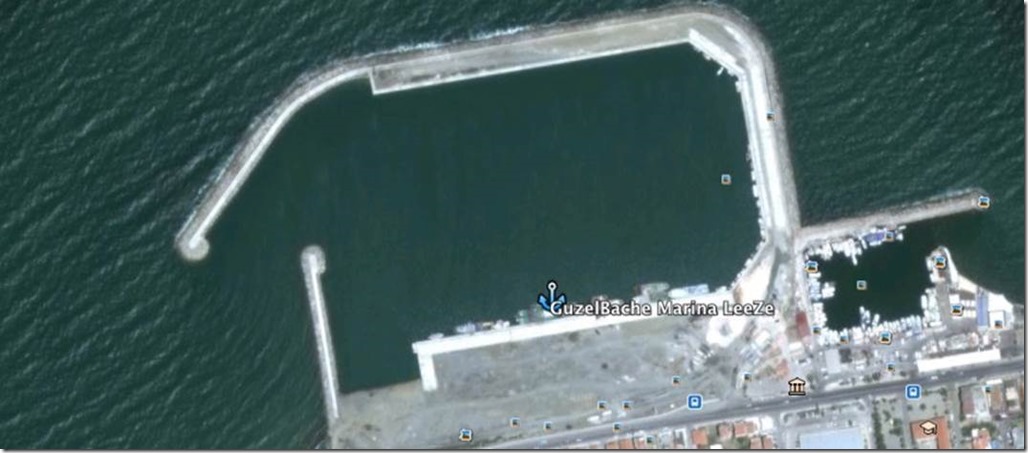
we got in, side too, into a half finished marina. If all goes well, we will stay here a while and then proceed to our winter marina, Levent, some 10 miles to our east. There is a three day religious holiday at the end of this week celebrating Abraham willing to slaughter his son, but instead did a lamb. The Turks tend to take these holidays and stretch them into a full week off, and this is no different. We saw Turk tourist showing up in Eski Foça Friday evening thru Saturday, starting what was to be a 8-9 day holiday!
Here is not a touristy area so we expect that less will be open than normal. Things get back to normal a week from tomorrow. Tonight we are going to a fish restaurant where you by what you want to eat from the fish merchant out front and then go to the restaurant where they cook it for you for a nominal fee. People drive for miles to come here. We are 100 meters away! What luck!!!
2015-09-21 Well, we did NOT go to that fish restaurant because the restaurants were way too crowded and the choice of fish was limited. We instead went to a kebab restaurant right across the street from the entrance to the marina and Zehra had the best chicken kabab in her life (per her!). I had a cheese and egg pide (‘turkish pizza”) but while mine was good, it was not extraordinary.
Will try again. Did some work today and probably will do more tomorrow. Quiet day.
2015-09-24 Yesterday, visited Çesmealti and Urla, two ports within 5-6 nm of where we are, though to the west. We have tried for years to go to the wall in both places and have been consistently told, no room. When we visited, neither had room. There are good anchorages closely and the towns are very lively all summer, and usually lively on weekends during the Fall and Spring, providing the sun is out.
Zehra did go a few days ago to visit Levent marina, our winter “home” and learned that they are ready for us, that we will be moored next to two other Asboat built Diesel Ducks 42s, and that should make for an interesting winter.
2015-09-28 I FINALLY got a chance to go to the fish market two nights ago, buy my calamari and 10 tiger shrimp, take them to a seaside restaurant where for 14 TL (Currently about 3TL=$1), they cooked up my fish and Zehra’s (whole) fish. The calamari was scrumptious and the shrimp were as dense as a fine cut of beef. Zehra was quite happy with her fish also!
Yesterday, we went to Izmir by bus and subway and walked around Konak to Alsancak. In Aug 2011, we were moored stern to to Pasaport Pier (located between Konak and Alsancak) with other boats. Now, 4 years later, the authorities have removed most of the mooring bits and locked up tight the electrical / water distribution boxes, so there are no pleasure craft there now. There were some sailboats moored at Konak Pier (a shopping mall built on a disused pier), but even they are gone. The authorities also removed all of the cafe and bars’ tables and chairs that use to abut the seawall so now there are few areas to sit and enjoy the view, and no place along the seawall to get a tea, coffee or a bite to eat. The area appears to have been “sanitized.” (It was more fun to walk there back then than now!)
There were rumors that the authorities were going to create a marina at this spot, but there is no indication. The Port of Izmir is also moving somewhere up the coast, but even that seems to be going slowly, as there were 12 ships at anchor waiting for the religious holiday to end so they could come in and either offload or load their cargo. The Turkish Navy did announce some years ago that it was returning the base it has opposite the Port back to the city but we saw ships still there yesterday. Someone told me that the city wants to put a marina where the Port is, which may make better sense as there is a lot of infrastructure that can be reused, but we saw no evidence that was happening. When we left Güzelbaçhe, there was hardly any wind but along Pasaport Pier, the wind was 20+ knots and the water was choppy and splashing onto the sidewalks. (It seems like lots of projects get proposed, some started, and even fewer finished. Funding is always an issue as much of what is needed to complete these projects is not produced in country with locally sourced materials.)
We ended up walking to Alsancak and having dinner on its main street, before taking two busses back to LeeZe. We were out and about nearly 7 hours and we were beat.
2015-09-29: Underway this morning at about 0900 for Levent Marina where we will winter over. The seas were calm and there was no wind. Numerous SAR (Search and Rescue) announcements were on the NavTex as even the refugees found this to be a good day to cross, and they were doing it in a big way, given the number of SAR messages. Channel 16 was also full of SAR traffic, and as I was entering the narrow choke point of Izmir Bay, a Turkish Navy frigate was just leaving it at flank speed.
We approach the marina, having already made arrangements by phone for them to take our tender first, tie it off, then get us in, and then bring back the tender. One of the tubes is leaking air, and the marina staff will have their tender repair person look at ours this week, hopefully.
Levent is a very SMALL marina, maybe room for 40-50 boats in the water? Our spot is on the north side of the marina, very close to the bathrooms but not the showers. We are moored next to a Diesel Duck 42 named Jackson, home port New Castle, De. Zehra has met them. The builder that built LeeZe also built Jackson.
The wind is dead calm and with a little push on the stern from the helper’s boat, we slide into our spot.
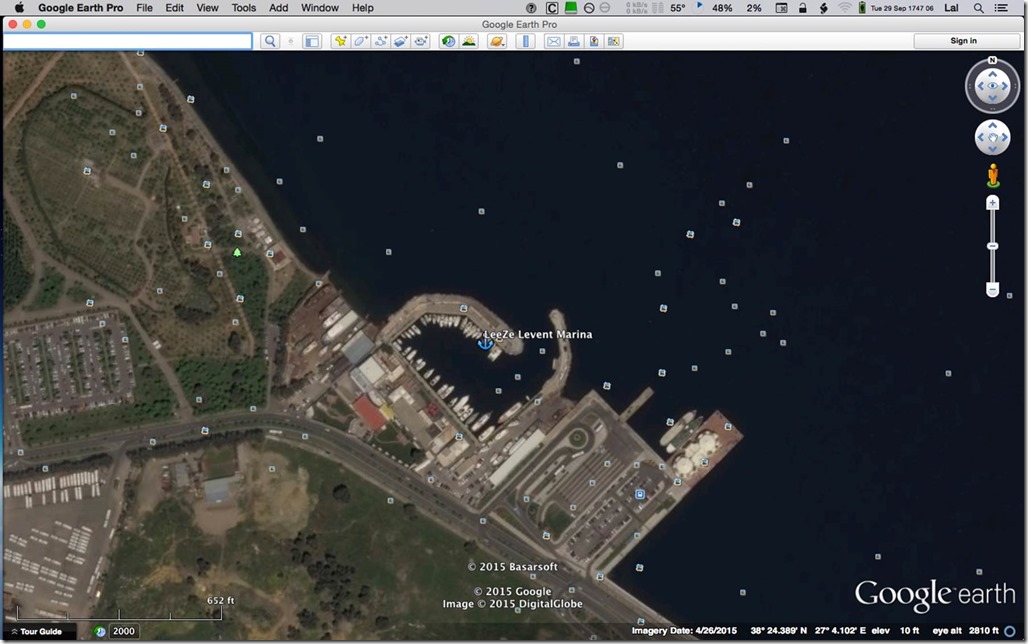
I take the bow lines from the marina staff and these will keep LeeZe from slamming into the dock. It is early still so decide to get the heavy lifting done while adjusting the stern lines. I retrieve the winter springs and chains and within an hour, that work is done. The marina uses a LARGE 63 amp 3 phase shore power connector which must be the only one I do not have. A quick call to their electrician and I am in business. They are still working on water and we should have that tomorrow.
2015-10-08: It looks like we are staying. There was a chance that we would not, as a club nearby played music with a very heavy bass element last weekend until 3 AM. Zehra could not sleep. If this goes on every weekend, Zehra did not want to stay. We have come to learn it does not. The bars and clubs around here play music until midnight on weekends, which is OK. The late music is for special occasions, like weddings.
We did get water. We have electricity. The yard’s small inflatable tender repair man came by last night at about 2000 and found numerous small leaks, most of them on the stern tubes’ joints, which he said was caused by leaving the boat uncovered during the hot and bright Turkish summers. Our current cover has too many holes in it to fix, so we were planning on getting a new one made. Now it looks like we need a lightweight summer one also. Ugh!
So, this concludes the 2015 Where is LeeZe’s blog. We traveled over 400 nm on this trip, with an average speed over ground of 5.6 knots, consuming somewhere just under 400 liters of fuel. The generator consumed less that 15 so all and all, we did OK.
We plan to go to Ankara to do a mini-family reunion and retrieve our car sometime during the middle of the month. Zehra will stay and vote and then, if Mom is willing and the weather remains nice, Mom and Zehra will fly back. I will stay a week, get some chores done and return with the car. That’s the plan today, and it could all change in a blink of an eye.
Thanks for reading!
Any questions?
Lee and Zehra
Izmir, Turkey
Some additional notes. We have been wise with the use of water so we did not need a water delivery while in Güzelbaçhe. The Fall sun is not as strong as a June-July sun (duh☺) so we ended up running the genset some 13+ hours over the last 9 days. We have also had 3 days of really cloudy weather so that did not help.
Some of my long time readers may remember that the genset was not a reliable machine. It would overheat all the time. I left the yard with it overheating as the manager blamed me for it overheating.
So, it took to our second winter to figure out that the hard plastic pipe the yard used to run the cooling water to the keel cooler was blocked with the excessively applied pipe goop that is used to seal the pipes’ joints. That was one fix. The next fix was to remove a restrictor the yard put in a water recirculating hose. The thought was if “we” could slow down the rate the genset came up to operating temp (80C) then there would be more time to get a charge into the battery. I removed it because I needed to put the machine back in its original condition if I was to continue to trouble shoot the problem.
The genset came with a 3 piece sound shield and I had taken off the end so I could check the oil level before starting. With that off, other problems started to show up. Start the engine and its rpm would vary all over the map. With the cover off, I could see small bubbles in the clear fuel filter so I had to tighten and then wrap with plastic wrap, the incoming fuel line all the way from the tank under the master cabin to the corner of the engine room where the genset was. Got that problem solved but then the load that the genset could carry was ridiculously low before the engine would die. I assumed that the little 1 cylinder diesel just did not have enough strength to suck the fuel needed from the tank, so I bought a 41 liter diesel fuel tank and had the genset suck from it. (I had toyed with the idea of using my fuel recirculation pump to push fuel to the genset, but then if that failed, I could not run the genset. So, I bought the tank. I can also use it in an emergency as a day tank for the main engine if all hell broke loose☺.)
So, as a result of the above, I could now get the genset to operate at 50-55% of full load for over an hour before it would shutdown on over temperature.
Then, I made a mistake during the second cruising season and allowed the genset to run dry. I thought I had enough fuel in the tank. I did not. To bleed the engine, I had to take the middle sound shield off. There was also the pipe cap for checking the water, which I check at the beginning of every season. When I checked it two seasons ago, it was low so I added. And added. And added. I ended up adding nearly 7 liters of water-antifreeze to the tank, which is connected to the keel cooler. So, then, I started the engine, ran it for 15 minutes, and checked level, adding whatever was needed until no more could go in.
Now, the engine lasted 1.5 hours. This got me thru last season and over the winter, I made no additional headway into resolving this issue. (It turns out I did NOT try hard enough!)
The next thing I did was to keep off the middle sound shield after checking the water, bleeding the engine, and put a fan on the motor end of the genset. I did that while here in Güzelbaçhe. (This is not the first time this boating season I have needed the genset, but this is the first time where I will need it for days!) That appeared to do the trick. I ran the engine now consistently for 6-9 hours (3 hours at a time) and with the fan on, the engine did not overheat. (I only do 3 hour run times as I usually stop the genset when no matter how much I load the engine manually, the battery charger is calling for less amps to charge. No use wasting fuel!)
Since the manufacture of this 4 kW genset has been bought out by someone bigger, it took me some time to track down the man I bought it from.
Here is what he told me. They built only ONE keel cooled genset, mine. When I paid them to provide the calculation for the keel cooler, he provided two answers to the yard: One for the genset enclosed in the sound shield, and one not. The size of the required keel cooler for the one in the sound shield was about 6 times BIGGER than the one without with a much larger water recirculation pump than the one that came with the unit. The yard, seeing that, probably decided that it was impractical to make the big keel cooler and so, installed the small one. I guess someone forgot to tell me that I needed to run the genset “naked.”
That would explain a lot.
Right now I am limited to loading the genset to 100 amps, the maximum charge one of my two battery chargers can put out. I did not want to jinx anything so this winter, will try using both battery chargers. Per the manufacturer notes in the manual, while the machine can handle two battery chargers, to avoid load shifting from one to the other, one should be set 15-20% lower than the other. (The genset is only connected to the battery chargers. I did try to find a DC genset when building LeeZe but the smallest I could find was a 12Kw unit. I thought that was way too big. I tried to get a 6 Kw custom built but that turned out way too hard. So, I ended up buying this small 4 Kw AC genset. )
If this all works out, I intend to see if the genset will run at 75% load, with is about 3 Kw (with a fan, and then maybe without the fan). That would mean that if I can load one battery charger to ~ 80 DC amps, and the other to 40, then I can get a quicker charge.
Right now, this is on the back burner as a winter project.
I know I am cheating but I use a fan on both alternators all the time when running the main engine, and during the winter, I use a fan on the battery chargers. I know heat (and the salty air) is the enemy here so if by keeping these components maybe just a little bit cooler, I can get them to laster longer. In a perfect world, I would not need a fan, but this world is far from perfect!
Lee
2015-10-08
Izmir, Turkey
That concludes this entry.
If you have any questions, please ask.
Lee and Zehra
MV LeeZe
You can find older blog posts here: http://whereisleeze.blogspot.com
